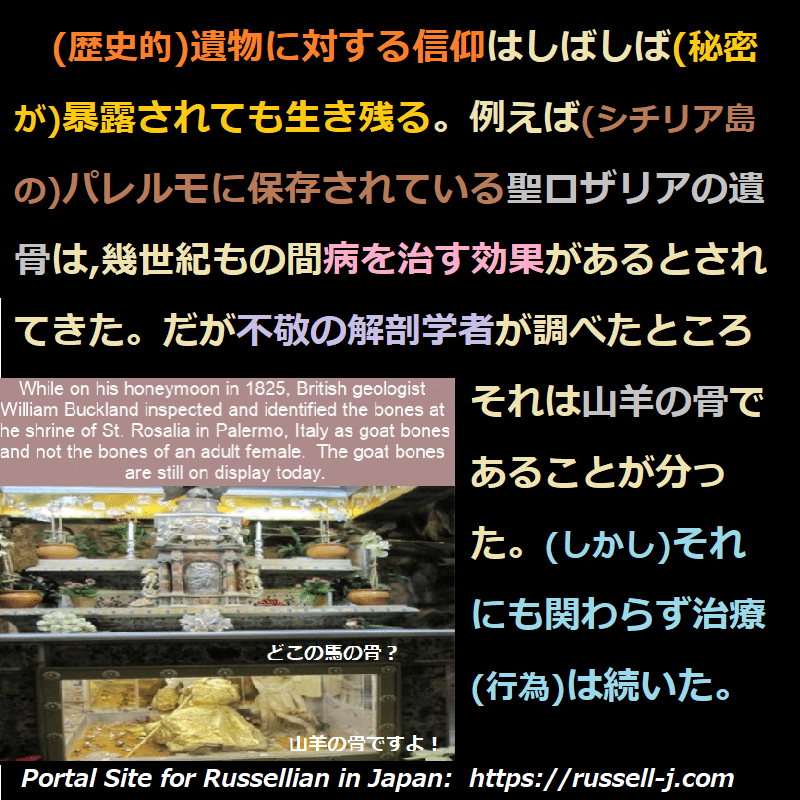
(歴史的な)遺物の効果に対する信仰は,中世を通して増していった。そうして,今日でもそれは失われていない。貴重な遺物を所有していることは,キリスト教会や貴重な遺物が存在している都市の収入源であり(注:都市が所有しているのではなく、教会が所有しているので、その教会がある都市も恩恵を受けるということ),エフェソの信徒たちを聖パウロに対して奮起させた(roused against)のと同様の経済的動機を発揮した(brought into play)。(歴史的)遺物に対する信仰は,しばしば,(秘密が)暴露されても生き残る。例えば,(シチリア島の)パレルモに保存されている聖ロザリアの遺骨は,幾世紀もの間,病を治す効果があるとされてきた。だが,不敬の解剖学者が調べたところそれは山羊の骨であることが分った。(しかし)それにも関わらず治療(行為)は続いた。今日,我々は,ある種の病は,信仰によって(信仰の力で)治される,その他のものはそうでないことを知っている(注:病は気から/うどんこの玉でも薬だといって飲ませれば治ることがある、というニュアンス)。疑いもなく,治癒の「奇蹟」は起るが,非科学的な雰囲気(環境)のなかにおいては,伝説は間もなく事実を誇張し,このようにして治すことができるヒステリー症の病と,病理学にもとづく処置を必要とする他の病との区別を消し去ってしまう。 興奮した雰囲気の中で伝説が拡まってゆくことは第一次世界大戦中に異常な実例が(いくつか)存在した問題である。(例えば)大戦勃発後の最初の数週間にイギリスを通ってフランスに行ったと考えられたロシア人たちの場合のような実例である。そのような信念の起源をもし追跡できたならば,歴史家が(断定できないが)見たところでは(apparently)疑うことができない歴史的証拠によって何を信ずべきかを判断する助けになるだろう。稀にみる完全な例として,イグナチウス・ロヨラの友人で,極東における最初のそして最も著名なイエズス会宣教師であったフランシスコ・ザビエルの奇蹟(と言われるもの/想定されたもの)を例にとってみょう。(原注:この主題についてはホワイト(著)『科学と神学との闘争』のなかで見事に取り扱われており、私も大いに彼に恩を受けている。)
Chapter 4: Demonology and Medicine, n.2
Belief in the efficacy of relics increased throughout the Middle Ages, and is still not extinct. The possession of valued relics was a source of income to the church and city in which they were, and brought into play the same economic motives which roused the Ephesians against St. Paul. Belief in relics often survives exposure. For example, the bones of St. Rosalia, which are preserved in Palermo, have for many centuries been found effective in curing disease ; but when examined by a profane anatomist they turned out to be the bones of a goat. Nevertheless the cures continued. We now know that certain kinds of diseases can be cured by faith, while others cannot ; no doubt “miracles ” of healing do occur, but in an unscientific atmosphere legends soon magnify the truth, and obliterate the distinction between the hysterical diseases which can be cured in this way, and the others which demand a treatment based upon pathology. The growth of legend in an atmosphere of excitement is a matter of which there were extraordinary examples during the War, such as the Russians who were supposed to have passed through England to France during the first weeks. The origin of such beliefs, when it can be traced, is valuable as a help to the historian in judging what to believe in apparently unquestionable historical testimony. We may take, as an unusually complete instance, the supposed miracles of St. Francis Xavier, the friend of Loyola, and the first and most eminent of Jesuit missionaries in the East. (note: This subject has been admirably treated in White’s Warfare of Science with Theology, to which I am much indebted.)
出典:Religion and Science, 1935, chapt. 4:
情報源:https://russell-j.com/beginner/RS1935_04-020.HTM
